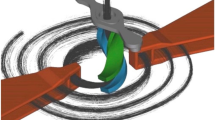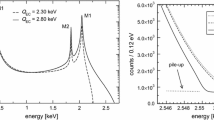Abstract.
Radiochemical experiments made the history of neutrino physics by achieving the first observation of solar neutrinos (Cl experiment) and the first detection of the fundamental \( pp\) solar neutrinos component (Ga experiments). They measured along decades the integral \( \nu_{e}\) charged current interaction rate in the exposed target. The basic operation principle is the chemical separation of the few atoms of the new chemical species produced by the neutrino interactions from the rest of the target, and their individual counting in a low-background counter. The smallness of the expected interaction rate (1 event per day in a \( \sim 100\) ton target) poses severe experimental challenges on the chemical and on the counting procedures. The main aspects related to the analysis techniques employed in solar neutrino experiments are reviewed and described, with a special focus given to the event selection and the statistical data treatment.
Similar content being viewed by others
References
R. Davis et al., Phys. Rev. Lett. 20, 1205 (1968)
B. Pontecorvo, Chalk River Lab. PD-205 report (1946)
J.N. Bahcall, Phys. Rev. Lett. 12, 300 (1964)
BOREXINO Collaboration, Nature 512, 383 (2014)
A. Serenelli, S. Basu, J. Ferguson, M. Asplund, Astrophys. J. L123, 705 (2009) arXiv:0909.2668 and A. Serenelli, arXiv:0910.3690 (2009)
T. Schwetz, M. Tortola, J.W.F. Valle, New J. Phys. 10, 113011 (2008)
B.T. Cleveland et al., Astrophys. J. 496, 505 (1998)
J. Boger et al., Astrophys. J. 537, 1080 (2000)
B.T. Cleveland et al., Nucl. Instrum. Methods 214, 451 (1983)
SAGE Collaboration (A.I. Abdurashitov et al.), Phys. Rev. C. 60, 055801 (1999)
SAGE Collaboration (A.I. Abazov et al.), Phys. Rev. Lett. 67, 3332 (1991)
GALLEX Collaboration (P. Anselmann et al.), Phys. Lett. B 285, 376 (1992)
GNO Collaboration (M. Altmann et al.), Phys. Lett. B 490, 16 (2000)
SAGE Collaboration (J.N. Abdurashitov et al.), Phys. Rev. C 80, 015807 (2009)
D Frekers et al., Phys. Rev. C 91, 034608 (2015)
SAGE Collaboration (J.N. Abdurashitov et al.), Phys. Rev. C. 59, 2246 (1999)
GALLEX Collaboration (P. Anselman et al.), Phys. Lett. B 342, 440 (1995)
GALLEX Collaboration (W. Hampel et al.), Phys. Lett. B 420, 114 (1998)
SAGE Collaboration (J.N. Abdurashitov et al.), Phys. Rev. C 73, 045805 (2006)
Gallex Collaboration (W. Hampel et al.), Phys. Lett. B 436, 158 (1998)
R. Wink et al., Nucl. Instrum. Methods A 329, 541 (1993)
W. Hampel, L.P. Remsberg, Phys. Rev. C 31, 667 (1985)
GALLEX Collaboration (W. Hampel et al.), Phys. Lett. B 447, 127 (1999)
GNO Collaboration (M. Altmann et al.), Phys. Lett. B 616, 174 (2005)
M. Cribier et al., Astropart. Phys. 6, 129 (1997)
F. Kaether et al., Phys. Lett. B 685, 47 (2010)
L. Pandola et al., Nucl. Instrum. Methods A 522, 521 (2004)
J.N. Abdurashitov et al., Astropart. Phys. 25, 349 (2006)
P.A. Sturrock, M.A. Weber, Astroph. J. 565, 1366 (2002)
D.O. Caldwell, P.A. Sturrock, Nucl. Phys. B (Proc. Suppl.) 124, 239 (2003)
L. Pandola, Astropart. Phys. 22, 219 (2004)
J.N. Bahcall, Phys. Rev. C 56, 3391 (1997)
M. Acero, C. Giunti, M. Laveder, Phys. Rev. D 78, 073009 (2008)
G. Bellini et al., JHEP 08, 038 (2013)
Author information
Authors and Affiliations
Corresponding author
Additional information
Communicated by C. Broggini
Rights and permissions
About this article
Cite this article
Cattadori, C.M., Pandola, L. Experimental and analysis methods in radiochemical experiments. Eur. Phys. J. A 52, 83 (2016). https://doi.org/10.1140/epja/i2016-16083-4
Received:
Accepted:
Published:
DOI: https://doi.org/10.1140/epja/i2016-16083-4




